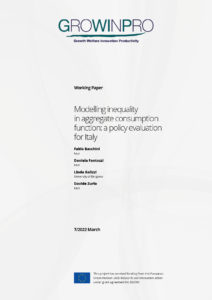This work explores the interaction of the inequality in the aggregate consumption function for the Italian economy. Measures of inequality are derived by exploiting the rich information in the EU-SILC survey available from 2003 up to 2018 matched with the World Inequality Database (WID) to span a larger sample. According to these measures, Italian income inequality rose substantially along with economic crisis, when credit constraints were strict and consumption smoothing less feasible. We use the specification in the macro-econometric model for the Italian economy developed by Istat (Memo-It) to test different indicators for inequality versus the aggregate consumption function. The results suggest that the P90/P10 index is statistically significant and negatively related. The augmented consumption function promises to assess better the impact of redistributive policies recently launched by the Italian government. Particularly, the impact of the Italian “Reddito di Cittadinanza – Citizens’ income” (RdC) has been evaluated in aggregate consumption and GDP. Using the new equation, we find that the RdC in 2020 will increase GDP by 0.4 percentage points and aggregate consumption by 1.1 pp. com- pared to the baseline scenario wherein the consumption function does not include the inequality index.

 Modelling inequality in aggregate consumption function: a policy evaluation for Italy
Modelling inequality in aggregate consumption function: a policy evaluation for Italy